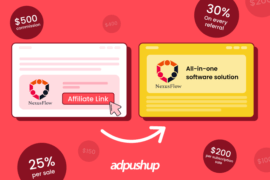Our monthly ad tech wrap-up gives publishers and advertisers a look at the latest news in ad technology, ad blocking trends, and funding. Read now!
Our ad tech monthly wrap-up covers the most important news in ad technology, ad blocking trends, funding, and other topics of interest to web publishers and advertisers.
Quick Brief
-
While advertisers and publishers experiment with new mobile ad formats and mix-model ad stacks including RTB waterfall, header bidding, and S2S header bidding, The Washington Post has decided to dump ad tech partners that are slowing down its website.
-
In partnership with Coalition for Better Ads, Google is planning to launch its own ad blocker that will come bundled with Chrome, while noted by analysts as a good move for the ad industry, publishers are worried about ad blocking further eating into their already diminishing revenues.
-
Despite an overall declining trend in ad tech investments, new ad tech companies continue to receive funding from investors and there’s still scope for bid deals, as demonstrated by Adobe’s acquisition of ad tech company Moat for $850 million.
AdTech
Innovation, implementation use cases, and industry trends
The Washington Post Selectively Drops Ad Tech Partners
“We go to our partners and say, ‘This is how fast things need to be executed; if you don’t hit this threshold, we can’t put you on the site,’” said Jarrod Dicker, the Post’s head of ad product and technology. “We found that vendors we do use are ones that went back to their engineering teams and found out how to expedite their loads. … The vendors that haven’t been able to come to the table with faster solutions, we no longer integrate with.” The Post declined to name which vendors they’ve dropped or share how many vendors they’re currently working with. But Dicker said that over the past year, the publisher has decreased its reliance on vendors “significantly.” (source)
Next Up in Mobile Ad Tech: Custom Ad Formats
Two areas that had once been siloed, ad tech and creative are now coming together to make ads effective. Mike Isabella, director of customer engagement at outdoor apparel and footwear company Timberland, and Daniel Meehan, founder and CEO of mobile advertising technology provider PadSquad, spoke with eMarketer’s Maria Minsker about the success Timberland has had with custom ad formats—and why ad tech players can no longer afford to ignore creative. (source)
Ad Revenue Predicted to Grow at 3.7% in 2017
Global ad growth will slow in 2017 to 3.7%, with total advertising revenues reaching $511 billion, according to Interpublic Group’s Magna. By comparison, Magna estimates that 2016 ad revenue grew at a stronger 5.7% pace, reaching $493 billion. Magna states the slower rate of growth is attributable to lack of cyclical events such as the Olympics and major political campaigns that added $3.5 billion in incremental ad spend last year […] Digital-based ad sales are approaching 40% of total sales in 2017 and projected to reach 50% by 2021. Magna found social and search captured the bulk (95%) of digital dollar growth in 2016: $10.5 billion out of $11 billion total net growth. (source)
The Meredith Case: How Big Publishers Manage Their Ad Stack
Meredith — the parent company of lifestyle and food brands like Martha Stewart Living and Better Homes and Gardens — uses waterfalling, on-page header bidding and server-to-server connections to sell its display inventory. Meredith also moves bidders in and out of these various channels depending on how they affect latency and revenue. “Header bidding is not a panacea,” said Chip Schenck, vp of data and programmatic solutions at Meredith. “It’s just one of the ways for demand to access the inventory.” (source)
Ad Blocking
Updates and opinions about ad blocking
Google to Launch Inbuilt Ad Blocker in Chrome
The ad-blocking feature, which could be switched on by default within Chrome, would filter out certain online ad types deemed to provide bad experiences for users as they move around the web. Unacceptable ad types would be those recently defined by the Coalition for Better Ads, an industry group that released a list of ad standards in March. According to those standards, ad formats such as pop-ups, auto-playing video ads with sound and “prestitial” ads with countdown timers are deemed to be “beneath a threshold of consumer acceptability.” (source)
The End of Bad Ads?
The Coalition for Better Ads, a consortium of ad, publishing, and tech companies, wants to save the advertising industry—by killing it. Or at least parts of it. Companies in the coalition will discuss, among other idea, pre-installation of a selective ad-blocker on web browsers as a means to effectively purge the internet of the most intrusive types of ads, such as those that automatically play sound, take-up too much of your screen, or force you to wait a certain amount of time before you can dismiss them. (source)
Publishers Worried About Google’s Ad Blocker
While many publishers share Google’s interests in keeping the web safe for digital advertising, publishers aren’t without fear of Google’s dominance. The Coalition is described as a big tent, with Google being a founding member, but some members privately say they consider the Coalition to essentially be a front for Google. As evidence of the search giant’s power, many publishers contacted for this story said they were under strict NDA with Google not to breathe a word about the ad blocking plans. That alone speaks volumes to the power dynamic at play here. Google briefing publishers, not asking for collaboration here. (source)
Funding and M&A
Who’s getting funded?
Difficult Times for Ad Tech Startups
There was a time when ad-tech companies could make handsome profits by adding data associated with new users. But that was several years ago, when it was still possible for a startup to come out of nowhere with only a story about how their technology is a game-changer. Today, technology is just the starting point. Whether trying to enter on the demand side or the supply side, a viable business means having data at scale and sophisticated connectivity. That’s the crux of an industry driven by big data – those who enter the market late are behind because each iteration of technology reflects insights and application from real-world data. (source)
Oracle Buys Moat for $850 Million
Moat has had several incarnations, but most recently it has focused on its role as an auditor for digital ad buyers, where it tries to see if the ads marketers have paid for are appearing where they’re supposed to appear. Both Facebook and Google allow Moat to check in, to varying degrees, on ads that run on those companies’ platforms. Google’s YouTube recently announced that it would work with Moat to help advertisers verify that their messages aren’t running next to offensive videos. The deal hasn’t closed yet. When it does, Oracle says Moat will operate as an independent unit, but will be offered as part of the company’s “data cloud” suite of products. (source)
Singapore Based Ad Tech Company AdAsia Raises $12 Million in Series A
AdAsia, a one-year-old online advertising startup based in Singapore, has closed a $12 million Series A round from Japanese investor JAFCO. The company was founded in April 2016 by CEO Kosuke Sogo, the former managing director of Japan’s MicroAd in APAC, and COO Otohiko Kozutsumi, who had been with MicroAd Vietnam. It offers a single digital platform that integrates elements such as real-time buying, social targeting, and large exchanges like Adwords, DoubleClick and Facebook. It also offers solutions for video and mobile, and runs an influencer marketing program. (source)
FAQs
Any app (usually a browser extension) that blocks advertising from websites, including intrusive ads, is an ad blocker. The ad blocking software checks the domain names of the elements loading on the web page against massive blacklists while the site loads.
Skeptical Sally, a Chrome ad blocker is not necessary to browse the web. An ad blocker is an invaluable tool if you’re looking to block more annoying pop-ups and ads, block YouTube ads, and take control over your browsing.
Many people say they use ad blockers for different reasons, but the most common reason is that there are too many annoying ads.

Shubham is a digital marketer with rich experience working in the advertisement technology industry. He has vast experience in the programmatic industry, driving business strategy and scaling functions including but not limited to growth and marketing, Operations, process optimization, and Sales.








